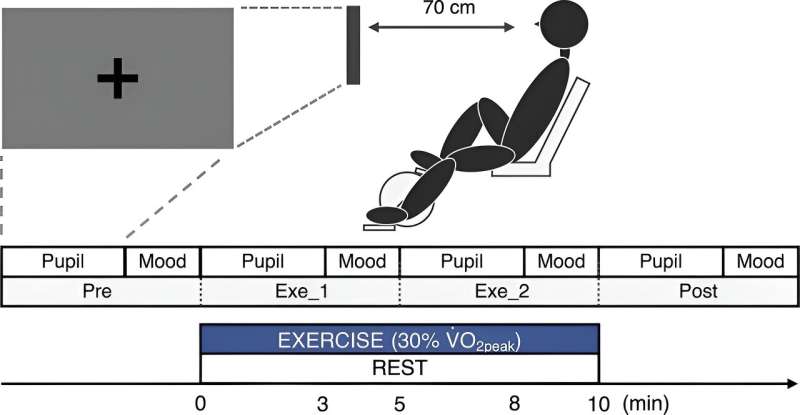This article has been reviewed according to Science X's editorial process and policies. Editors have highlighted the following attributes while ensuring the content's credibility:
fact-checked
trusted source
proofread
A possible contribution of the locus coeruleus to arousal enhancement upon mild exercise

Mild exercise results in a feeling of mental clarity and enhances cognition and memory. A possible mechanism behind such effects is the activation of the arousal center in the brainstem, thereby elevating the arousal level of the entire brain. However, it has been difficult to accurately measure the brainstem during exercise.
Last year, our research group from the University of Tsukuba discovered that mild (very light-intensity) exercise, equivalent to yoga or slow walking, enhances psychological arousal levels while simultaneously increasing pupil diameter. The latter is believed to reflect the brain's arousal state, particularly that of the locus coeruleus (an arousal system located in the brainstem).
Hence, we hypothesized that very light-intensity exercise activates the locus coeruleus. Moreover, magnetic resonance imaging (MRI) signal intensity originating from neuromelanin is reportedly related to locus coeruleus reactivity.
To test our aforementioned hypothesis, we investigated the relationship between the signal intensity of the locus coeruleus, derived from neuromelanin—a pigment contained within neurons in the locus coeruleus—obtained via MRI and the magnitude of pupil dilation and enhancement of psychological arousal induced by very light-intensity exercise.
We measured the signal intensity of the locus coeruleus, which is derived from neuromelanin accumulation, using MRI in 21 healthy young males. The participants also performed very light-intensity exercise on a separate day, enabling us to quantify changes in pupil diameter and psychological arousal.
We established a relationship between neuromelanin signal intensity in the locus coeruleus and the changes in pupil diameter and psychological arousal during very light-intensity exercise, with higher signal intensity being associated with a higher degree of pupil dilation and psychological arousal enhancement.
As mentioned above, neuromelanin-derived MRI signal intensity is related to locus coeruleus reactivity. Locus coeruleus activity during very light-intensity exercise could thus be more pronounced in individuals with higher signal intensity, thereby leading to higher exercise-induced pupil dilation and arousal enhancement. The results of this study support the hypothesis that the arousal centers in the brainstem, including the locus coeruleus, are activated by very light-intensity exercise, leading to improvements in mood and cognitive function.
The paper is published in the journal Cerebral Cortex Communications.
More information: Yudai Yamazaki et al, A possible contribution of the locus coeruleus to arousal enhancement with mild exercise: evidence from pupillometry and neuromelanin imaging, Cerebral Cortex Communications (2023). DOI: 10.1093/texcom/tgad010




















